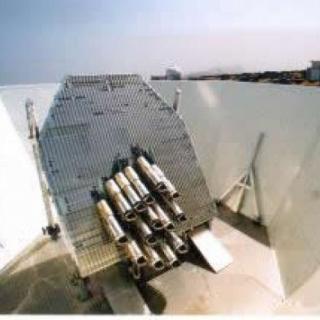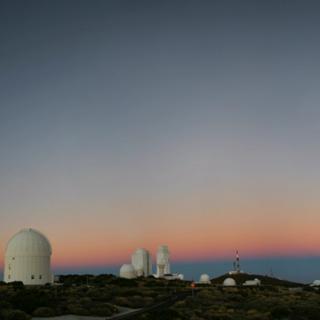Grants related:
General
The general goal of this project is to determine and characterize the spatial and spectral variations in the temperature and polarisation of the Cosmic Microwave Background in angular scales from several arcminutes to several degrees. The primordial matter density fluctuations which originated the structure in the matter distribution of the present Universe, left imprinted inhomogeneities in the CMB temperature distribution, that are mathematically encoded in the so-called angular power spectrum. Initially, pioneering experiments like the COBE satellite (whose results deserved the Nobel Prize on Physics 2006) or the Tenerife CMB experiment demonstrated in the 90s that the level of anisotropy was about one part in a hundred thousands at angular scales of several degrees. Obtaining CMB maps at various frequencies with sufficient sensitivity to detect structures at this level is of fundamental importance to extract information on the power spectrum of primordial density fluctuations, to prove the existence of an inflationary period in the Early Universe and to establish the ultimate nature of the dark matter and dark energy. Recently, the WMAP satellite obtained CMB maps with unprecedented sensitivity that allowed to set restrictions on a large number of cosmological parameters.
The focus of this project is to undertake measurements at gradually higher angular resolutions and sensitivities, by using different experiments that have been operative from the Teide Observatory, like the Tenerife experiment, the IAC-Bartol experiment or the JBO-IAC interferometer. More recently, the Very Small Array interferometer performed observations between 1999 and 2008. At that time the COSMOSOMAS experiment was also operative, its goal having been not only the characterization of the primary CMB anisotropies but also the study and characterization of the Galactic foreground contamination. In more recent years the activity in this project has focused in the scientific exploitation of data from the Planck satellite, and in the development, operation and exploitation of the QUIJOTE experiment. Now that the Planck mission has been completed and finished, the activity is focused in the scientific exploitation of QUIJOTE, in the development of new instrumentation for QUIJOTE, and in in the development of new experiments that are being deployed or that will be deployed at the Teide Observatory: GroundBRID, STRIP, KISS and TMS.
Members
Results
- 6-7 june: XV QUIJOTE Scientific Meeting (IFCA, Santander)
- July: publication of the final results (12 articles) and data from the Planck satellite.
- 15-19 october: "CMB foregrounds for B-mode studies" conference, organised within the Radioforegrounds proyect, IV AME workshop, and XVI QUIJOTE Scientific Meeting (all these eventes were celebrated at the IAC)
- October: installation of the dome of the GroundBIRD experiment, at the Teide Observatory.
- December: aceptation of the third QUIJOTE scientific article (Poidevin et al. 2019)
Scientific activity
Related publications
-
Constraining the regular Galactic magnetic field with the 5-year WMAP polarization measurements at 22 GHzContext. The knowledge of the regular (large scale) component of the Galactic magnetic field gives important information about the structure and dynamics of the Milky Way, and also constitutes a basic tool to determine cosmic ray trajectories. It can also provide clear windows where primordial magnetic fields could be detected. Aims: We aim toRuiz-Granados, B. et al.
Advertised on:
112010 -
Planck early results. XXIV. Dust in the diffuse interstellar medium and the Galactic haloThis paper presents the first results from a comparison of Planck dust maps at 353, 545 and 857GHz, along with IRAS data at 3000 (100 μm) and 5000GHz (60 μm), with Green Bank Telescope 21-cm observations of Hi in 14 fields covering more than 800 deg2 at high Galactic latitude. The main goal of this study is to estimate the far-infrared to subPlanck Collaboration et al.
Advertised on:
122011 -
Planck early results. XVIII. The power spectrum of cosmic infrared background anisotropiesUsing Planck maps of six regions of low Galactic dust emission with a total area of about 140 deg2, we determine the angular power spectra of cosmic infrared background (CIB) anisotropies from multipole ℓ = 200 to ℓ = 2000 at 217, 353, 545 and 857 GHz. We use 21-cm observations of Hi as a tracer of thermal dust emission to reduce the already lowPlanck Collaboration et al.
Advertised on:
122011 -
Planck early results. XIX. All-sky temperature and dust optical depth from Planck and IRAS. Constraints on the "dark gas" in our GalaxyAn all sky map of the apparent temperature and optical depth of thermal dust emission is constructed using the Planck-HFI (350μm to 2 mm) andIRAS(100μm) data. The optical depth maps are correlated with tracers of the atomic (Hi) and molecular gas traced by CO. The correlation with the column density of observed gas is linear in the lowest columnPlanck Collaboration et al.
Advertised on:
122011 -
The Contribution of the Kinematic Sunyaev-Zel'dovich Effect from the Warm-Hot Intergalactic Medium to the Five-Year Wilkinson Microwave Anisotropy Probe DataWe study the contribution of the kinematic Sunyaev-Zel'dovich (kSZ) effect, generated by the warm-hot intergalactic medium, to the cosmic microwave background temperature anisotropies in the five-year Wilkinson Microwave Anisotropy Probe (WMAP) data. We explore the concordance ΛCDM cosmological model, with and without this kSZ contribution, using aGénova-Santos, R. et al.
Advertised on:
72009 -
The Arcminute Microkelvin ImagerThe Arcminute Microkelvin Imager is a pair of interferometer arrays operating with six frequency channels spanning 13.9-18.2GHz, for observations on angular scales of 30arcsec-10arcmin and for declinations greater than -15° the Small Array has a sensitivity of 30mJys-1/2 and the Large Array has a sensitivity of 3mJys-1/2. The telescope is aimedZwart, J. T. L. et al.
Advertised on:
122008 -
Kinematic Sunyaev-Zel'dovich Cosmic Microwave Background Temperature Anisotropies Generated by Gas in Cosmic StructuresIf the gas in filaments and halos shares the same velocity field as the luminous matter, it will generate measurable temperature anisotropies due to the kinematic Sunyaev-Zel'dovich effect. We compute the distribution function of the KSZ signal produced by a typical filament and show it is highly non-Gaussian. The combined contribution of theAtrio-Barandela, F. et al.
Advertised on:
22008 -
A blind detection of a large, complex, Sunyaev-Zel'dovich structureWe present an interesting Sunyaev-Zel’dovich (SZ) detection in the first of the Arcminute Microkelvin Imager (AMI) ‘blind’, degree-square fields to have been observed down to our target sensitivity of ?. In follow-up deep pointed observations the SZ effect is detected with a maximum peak decrement greater than eight times the thermal noise. NoAMI Consortium et al.
Advertised on:
62012 -
30 GHz observations of sources in the Very Small Array fieldsSmall angular scale (high l) studies of cosmic microwave background (CMB) anisotropies require accurate knowledge of the statistical properties of extragalactic sources at cm-mm wavelengths. We have used a 30 GHz dual-beam receiver (One Centimetre Receiver Array prototype) on the Toruń 32-m telescope to measure the flux densities of 121 sources inGawroński, M. P. et al.
Advertised on:
82010 -
Very Small Array observations of the anomalous microwave emission in the Perseus regionThe dust complex G159.6-18.5 in the Perseus region has previously been observed with the COSMOSOMAS experiment on angular scales of ~1°, and was found to exhibit anomalous microwave emission. We present the first high angular resolution observations of this dust complex, performed with the Very Small Array (VSA) at 33GHz, to help increase theTibbs, Christopher T. et al.
Advertised on:
32010 -
The Sunyaev-Zeldovich effect in superclusters of galaxies using gasdynamical simulations: the case of Corona BorealisWe study the thermal (tSZ) and kinetic Sunyaev-Zel'dovich (kSZ) effect associated with superclusters of galaxies using the MareNostrum (MNU) universe smoothed particle hydrodynamics (SPH) simulation. In particular, we consider superclusters with characteristics (total mass, overdensity and number density of cluster members) similar to those of theFlores-Cacho, I. et al.
Advertised on:
122009 -
The spatial distribution of galaxies within the cosmic microwave background cold spot in the Corona Borealis superclusterWe study the spatial distribution and colours of galaxies within the region covered by the cold spot in the cosmic microwave background recently detected by the Very Small Array interpherometer (VSA) towards the Corona Borealis supercluster (CrB-SC). The spot is in the northern part of a region with a radius ~1° (~5Mpc at the redshift of CrB-SC)Padilla-Torres, Carmen Pilar et al.
Advertised on:
62009 -
Radio source calibration for the Very Small Array and other cosmic microwave background instruments at around 30 GHzAccurate calibration of data is essential for the current generation of cosmic microwave background (CMB) experiments. Using data from the Very Small Array (VSA), we describe procedures which will lead to an accuracy of 1 per cent or better for experiments such as the VSA and CBI. Particular attention is paid to the stability of the receiverHafez, Yaser A. et al.
Advertised on:
82008 -
Planck pre-launch status: The Planck-LFI programmeThis paper provides an overview of the Low Frequency Instrument (LFI) programme within the ESA Planck mission. The LFI instrument has been developed to produce high precision maps of the microwave sky at frequencies in the range 27-77 GHz, below the peak of the cosmic microwave background (CMB) radiation spectrum. The scientific goals are describedMandolesi, N. et al.
Advertised on:
92010 -
Planck pre-launch status: The Planck missionThe European Space Agency's Planck satellite, launched on 14 May 2009, is the third-generation space experiment in the field of cosmic microwave background (CMB) research. It will image the anisotropies of the CMB over the whole sky, with unprecedented sensitivity ({{Δ T}over T} 2 × 10-6) and angular resolution ( 5 arcmin). Planck will provide aTauber, J. A. et al.
Advertised on:
92010 -
Planck pre-launch status: Design and description of the Low Frequency InstrumentIn this paper we present the Low Frequency Instrument (LFI), designed and developed as part of the Planck space mission, the ESA programme dedicated to precision imaging of the cosmic microwave background (CMB). Planck-LFI will observe the full sky in intensity and polarisation in three frequency bands centred at 30, 44 and 70 GHz, while higherBersanelli, M. et al.
Advertised on:
92010 -
Planck early results. V. The Low Frequency Instrument data processingWe describe the processing of data from the Low Frequency Instrument (LFI) used in production of the Planck Early Release Compact Source Catalogue (ERCSC). In particular, we discuss the steps involved in reducing the data from telemetry packets to cleaned, calibrated, time-ordered data (TOD) and frequency maps. Data are continuously calibratedZacchei, A. et al.
Advertised on:
122011 -
Planck early results. III. First assessment of the Low Frequency Instrument in-flight performanceThe scientific performance of the Planck Low Frequency Instrument (LFI) after one year of in-orbit operation is presented. We describe the main optical parameters and discuss photometric calibration, white noise sensitivity, and noise properties. A preliminary evaluation of the impact of the main systematic effects is presented. For each of theMennella, A. et al.
Advertised on:
122011 -
Planck early results. II. The thermal performance of PlanckThe performance of the Planck instruments in space is enabled by their low operating temperatures, 20 K for LFI and 0.1 K for HFI, achieved through a combination of passive radiative cooling and three active mechanical coolers. The scientific requirement for very broad frequency coverage led to two detector technologies with widely differentPlanck Collaboration et al.
Advertised on:
122011 -
Planck early results. I. The Planck missionThe European Space Agency's Planck satellite was launched on 14 May 2009, and has been surveying the sky stably and continuously since 13 August 2009. Its performance is well in line with expectations, and it will continue to gather scientific data until the end of its cryogenic lifetime. We give an overview of the history of Planck in its firstPlanck Collaboration et al.
Advertised on:
122011
Related talks
No related talks were found.Related conferences
-
XIX Canary Islands Winter School of Astrophysics "The Cosmic Microwave | Background: from quantum fluctuations to the present Universe"Tenerife, Canary IslandsSpainDate-Past
News





![Teacup in [O III] and CO(2-1) Supermassive black holes modify the distribution of molecular gas in the central regions of galaxies. Credit: HST and C. Ramos Almeida.](/sites/default/files/styles/crop_square_2_2_to_320px/public/images/project/teacup_english.001.jpeg?itok=dF4bDw-q)
